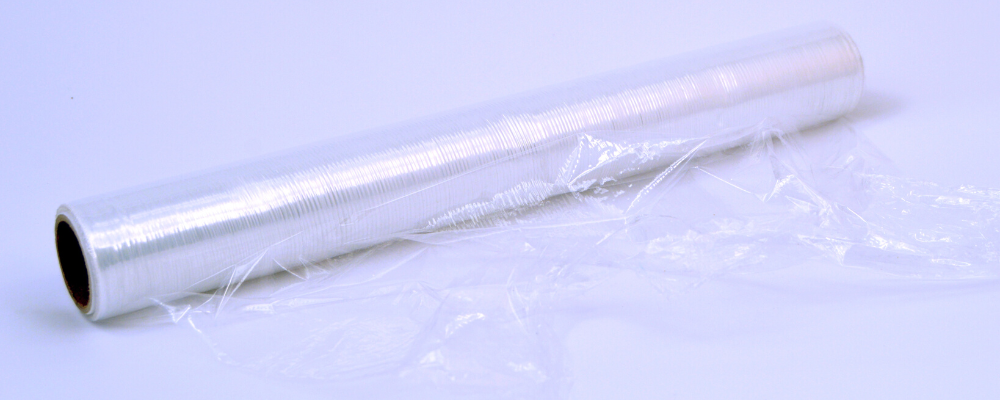By Sam Singer | January 08, 2023 0 Comments

How to Choose the Right Stretch Film
Stretch wrap is a plastic material that is elastic so it can be stretched tightly over material loads to secure the load for storing and shipping. Stretch film typically comes in a roll of plastic that can have varying degrees of load capacity and strength. Each type of stretch film has specific features for its intended application. When it comes to choosing the right stretch wrap for your applications, here are some tips to help you.
Different types of stretch film and their applications
Blown vs cast film and why
Blown film is made by extruding molten plastic through a circular die. The resulting tube of plastic is then cooled and flattened into a sheet. This type of film is typically thinner and more elastic than cast film.
Cast film, on the other hand, is made by pouring molten plastic onto a chilled roll. This creates a sheet of plastic that is then cooled and stretched. Cast film is typically thicker and less elastic than blown film.
So, which type of film is right for you?
When choosing between blown and cast film, there are a few factors to keep in mind. First, consider the thickness of the film. Blown film is typically thinner and more elastic than cast film, so it may be a better option if you need a film that's easy to work with. However, cast film is typically thicker and less elastic, so it may be a better choice if you need a more durable film.
Next, think about the climate. If you'll be using the film in hot weather, choose a blown film that's designed to resist heat-related damage. And if you'll be using it in cold weather, look for a cast film that won't become brittle when exposed to the elements.
Finally, consider your application. Blown film is often used for food packaging, while cast film is more commonly used for industrial applications.
Pre-stretch film
Pre-stretch film is a type of stretch film that's been stretched before it's used. This makes the film easier to work with and helps to ensure a tight, secure wrap. Pre-stretch film is often used for wrapping irregular or delicate loads, as well as for applications where a high degree of stretch is needed.
Specialty films
Vented
Vented stretch film is a type of stretch film that has small holes or vents punched into it. This allows air to circulate around the wrapped load, which is ideal for loads that need to breathe (such as produce). Vented stretch film is also often used for wrapping irregular or delicate loads, as the vents help to prevent the film from tearing.
Netting/ Mesh
Netted or mesh stretch film is a type of stretch film that has a net-like structure. Similar to vented stretch film, it allows air to circulate around the wrapped load. Netted or mesh stretch film is also often used for wrapping irregular or delicate loads.
Color/ Opaque
Stretch film is available in a variety of colors, and can even be made opaque. This can be helpful if you need to color-code your wrapped loads. Color or opaque stretch film is also often used for security purposes, as it's more difficult to see through than clear film.
Applying stretch film
Hand vs Machine Wrapping
When it comes to stretch film, you can choose between hand wrapping and machine wrapping. Hand wrapping is the process of manually wrapping a load with stretch film. This option is typically less expensive and more versatile than machine wrapping, as it doesn't require special equipment. However, it can be more time-consuming and physically demanding than machine wrapping.
Machine wrapping, on the other hand, is the process of using a machine to wrap a load with stretch film. Automated wrapping is typically faster and less physically demanding. Additionally, machine wrapping often results in a tighter, more secure wrap. When choosing the right wrapping technology for your business, consider the speed and effectiveness of your current packaging process and if you are meeting your business standards.
Thank you for reading!
If you're not sure which type of stretch film is right for your needs, contact us to talk with a packaging expert. We can help you choose the right type of film for your application.

About the Author: Sam Singer
Sam leads the sales and marketing efforts for Rapid Packaging. His career has taken him all over the country, living in 5 states and 3 regions in the past 12 years. A native of California, he is a graduate of the University of Portland (Portland, OR).
Before entering the packaging industry, Sam spent 25 years in wireless technology, leading teams regionally and nationally.
Sam’s approach to packaging is to focus on building solutions for customers. He has a rigorous focus on continuous improvement for customer value-add. He enables the sales force to support client needs by initiating ongoing training and skill development.
Sam lives in St. Paul, MN, with his wife and youngest of 5 children. He was proudly promoted to Grandpa in January 2021.
Need Help?
Increase your productivity with entry-level of full-line packaging automation, reduce packaging costs, and increase product protection with a full catalog of packaging supplies.